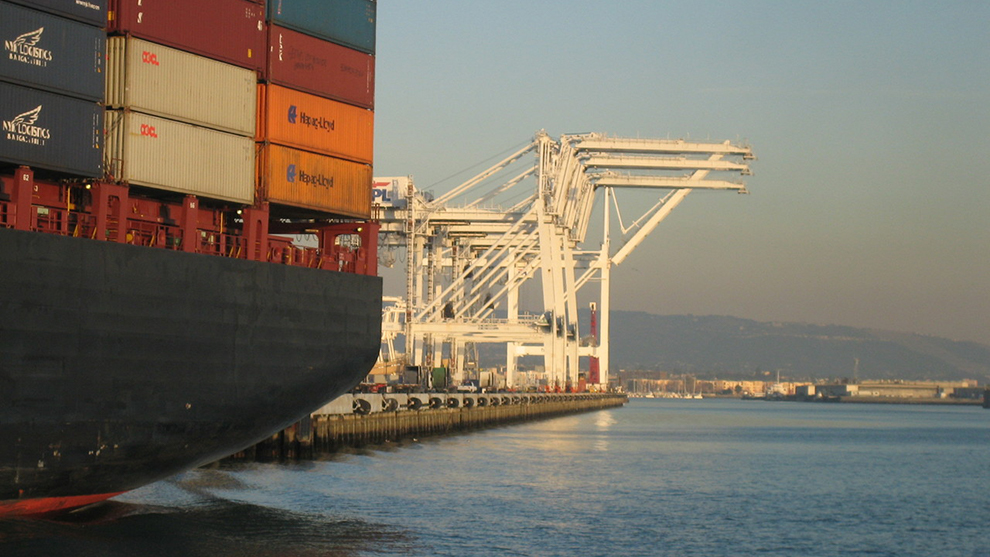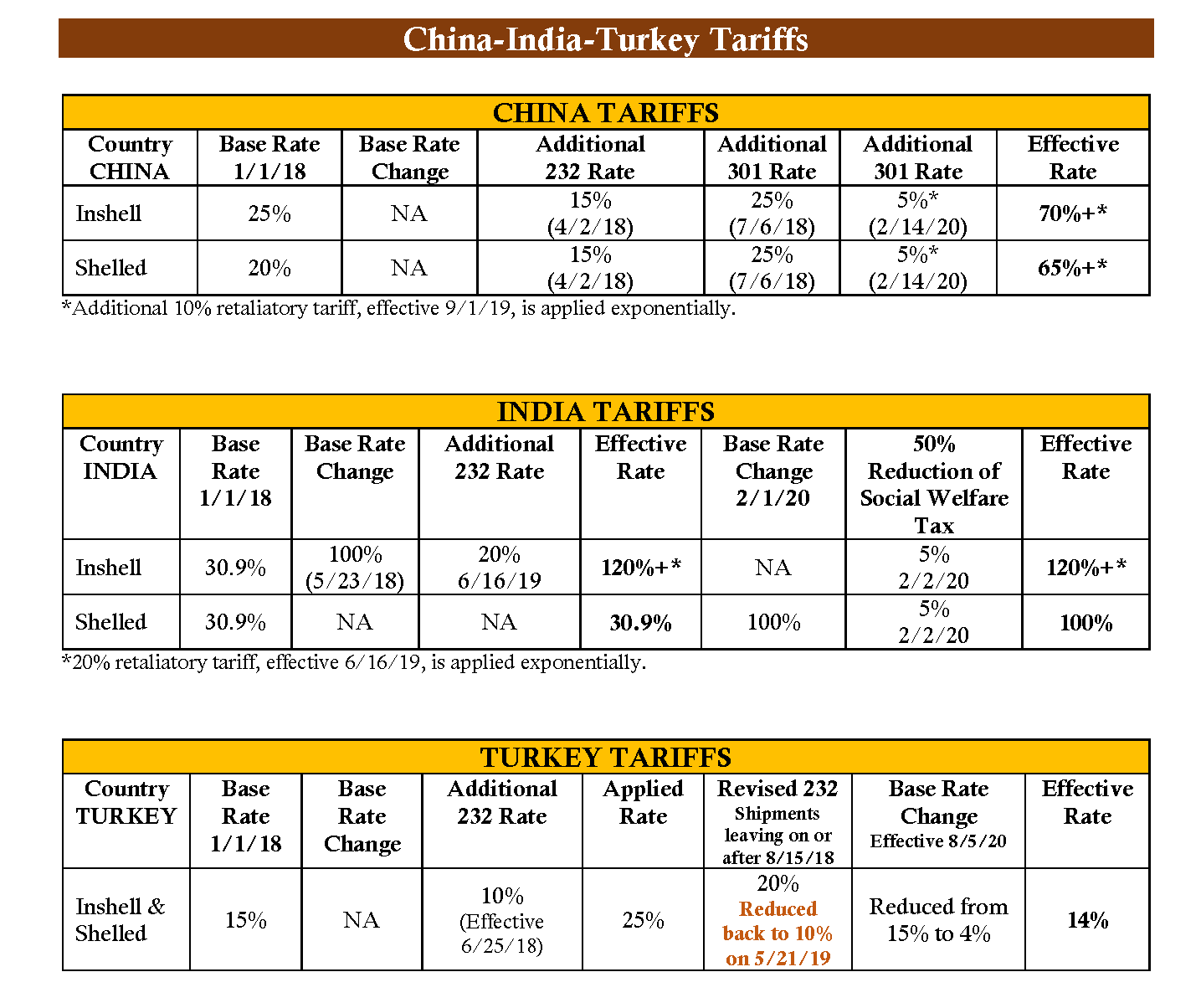
Industry leaders are keeping a close eye on international trade tariffs, which are adding as much as 120% to purchases of U.S. tree nuts by foreign buyers.
Lowering tariffs, or duties on imported goods, will help California almonds, walnuts and pistachios continue to expand sales abroad. But retaliatory trade policy and deteriorating U.S.-China relations have complicated efforts to reduce tariffs. The pandemic’s supply chain challenges and uncertainty over the outcome of the U.S. presidential election have further compounded trade concerns.
“The difficulty is that discussions about agriculture are not isolated from broader trade priorities,” said Julie Adams, vice president of Global Technical and Regulatory Affairs for Almond Board of California. “As we’ve seen, retaliatory tariffs are often in response to issues having nothing to do with our commodities.”
For example, tariffs shot up following the Section 232 steel and aluminum proclamation signed by President Trump in March 2018. The executive order imposed a 25% tariff on foreign-made steel and 10% on imported aluminum in an effort to bolster U.S. manufacturing.
Several countries, including China, retaliated by increasing tariffs on numerous American goods, including agricultural products. That spurred the U.S. to levy even higher tariffs, starting back-and-forth spikes with international trading partners.
Trade tensions between the U.S. and China began to ease with a phase-one deal between the two nations in January 2020. But issues remain. Among them are questions about supply chain origins, intellectual property violations, China’s subsidies to its state-controlled businesses and the volume of China’s purchases of American farm goods. These are expected to be resolved in a phase-two agreement, which has not yet taken place.
“The two things that could help nut producers in 2021 would be to reduce the tariff rates in places they export to, and to finalize bilateral agreements and the China phase-two agreement in the coming months,” said Sara Neagu-Reed, associate director of Federal Policy for the California Farm Bureau Federation. “Much of this will depend on how a new Biden Administration will approach agricultural trade policy.”
Those next steps, or even when the phase-two deal with China will happen, remain unclear, say industry leaders. In the meantime, here’s a closer look at how trade-war tariffs are impacting California’s three largest tree-nut industries.
Walnuts: Seeking a Level Playing Field
“When it comes to tariffs, there is good news and there are challenges,” said Michelle Connelly, CEO of the California Walnut Commission (CWC), the agency funded by grower assessments.
California’s walnut industry has faced tariff issues for decades, Connelly noted. But with the advent of Section 232 tariffs, plus additional Section 301 retaliatory actions, several countries have ratcheted up their tariffs on U.S. walnuts.
China is among them. While not yet a major market for California walnuts, the Asian powerhouse offers significant export potential. But market development progress hit headwinds when China raised its tariff levels on U.S. in-shell walnuts from 25% to 70%, and from 20% to 65% on shelled nuts.
Likewise, India is a market with huge potential. The Indian government increased trade levies on walnuts from 30.9% to 100% for both in-shell and shelled walnuts. In retaliation to Section 232 tariffs, India added another 20% to in-shell walnuts from the U.S., placing those duties at a 120% rate.
“We had been seeing very positive growth in India since the U.S. was allowed to enter that market in 2014,” Connelly said. “India’s walnut production is not sufficient to meet demand, so it needs to import. But the tariffs have significantly slowed our market growth there.”
There have been some positive tariff developments this year. A bright spot is Turkey, the No. 2 export market for California walnuts. In response to Section 232 actions, it had raised tariffs on U.S. walnuts from 15% to 25%. However, negotiations with the U.S. eventually resulted in Turkey lowering its rates to 14%.
In addition, the U.S. concluded a successful trade deal with Japan in January 2020. The third largest export market for California walnuts, Japan dropped its tariff from 10% to 0% for both U.S. walnuts and almonds.
“That’s extremely positive, a huge plus,” said Pam Graviet, CWC’s senior marketing director.
Such deals are key to growing markets for California’s walnut industry, Connelly noted. The Golden State typically exports 60% of its walnut crop. Moreover, 2020 produced a record walnut crop, increasing 130,000 tons over last year. Those factors underscore the need to gain greater access to global customers.
California’s walnut industry isn’t alone in working to overcome trade barriers. “Several commodities are fighting these battles,” Graviet said. “We’re all working with our congressional delegations, the U.S. Trade Representative and USDA so we can compete with fair and equitable trade.”
Almonds: Dynamic Trade Environment
Tariffs and the global environment are also key to the California almond industry, which exports about 70% of its total production.
“We probably will not see any dramatic changes in the trade and tariff situation early in 2021, regardless of who wins the election,” said the Almond Board’s Adams. “That said, we’re waiting to see what happens with trade-agreement negotiations with the U.K. and Europe.”
Those matter, since the European Union-28 (EU-27 plus the U.K.) is the largest export market for U.S. tree nuts, USDA’s Global Agricultural Information1 reported in September.
California’s almond industry is also eyeing China, which has increased tariffs on U.S. almonds from 10% to 55% since 2018. Five years ago, China was the second-largest export destination for California almonds. With its increasing middle class and export growth, the Asian giant was on track to expand. But retaliatory tariffs changed that momentum.
When China’s tariffs went into effect in April 2018, California’s almond industry began seeing the consequences. Almond shipments fell about 25% in the 2018-19 crop year. The next season, they were down about 23%. Now, China has dropped to No. 4 in U.S. export destinations for almonds.
“We’re hoping to see an uptick in shipments,” Adams said. “Given lower prices as we go into the new crop year, I’m hoping we will see that decline start to reverse itself. Further, with greater awareness of the tariff exclusion, more importers and buyers are starting to take advantage of the policy, which allows them to import almonds with a 25% tariff rather than 55%.”
That improvement is critical since other countries have since moved to capture market share.
“Australia was able to take advantage of its 0% duty and get a bigger foothold in China,” said Adams. “When you have disruption in the market, you have to expect that competing origins will benefit. While we’re fortunate that California almonds are so dominant in global production, we can’t be complacent. We need to continue to build demand for the long term and create a more favorable situation for California.”
Pistachios: Focus on China
China is where the largest tariffs and biggest issues lie for U.S. pistachios, said Richard Matoian, president of American Pistachio Growers.
The Asian nation is the main export market for U.S. pistachios, followed by the EU. Prompted by Section 232, the Chinese government increased its tariff levels from 15% to 55% on raw pistachios in 2018. The subsequent phase-one agreement lowered the rate to 30%.
Raw pistachios refer to those not roasted, whether they’re in kernel or in-shell form. They account for most of U.S. shipments to China. Due to the high tariffs and some earlier COVID-19 logistic problems, shipments of U.S. raw pistachios have reached only 123 million pounds in 2020, compared to over 240 million pounds last year.
But some opportunity appeared this fall. “The government of China has allowed importers there to petition the government for a lower 5% tariff if the existing tariff would hurt their business,” Matoian said. “As far as we’ve heard, a handful of large companies have successfully applied for and have been granted the 5% tariff. This is a small victory in the very large tariff issue.”
Even small victories count in the international trade arena, since more expensive imports can push a buyer like China to turn to other countries for pistachios, including chief competitors such as Iran and Turkey. That can lead U.S. suppliers to lower their prices to help make sales.
“Lowering tariffs opens up markets,” Matoian said. “We hope to see progress made in the phase-two negotiations with China to ultimately reduce existing tariffs on U.S. pistachios.”
















